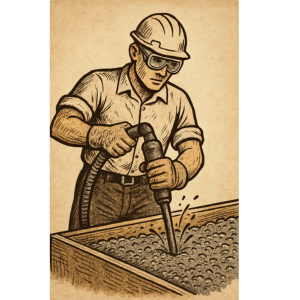VIBRATION
 |
|||

Need for Vibrating Concrete
Freshly poured concrete traps air. This trapped air weakens structural integrity, reduces durability and causes honeycombing and surface blemishes and can Inhibit bonding with reinforcement parts.
Vibrating concrete is a crucial process in construction to ensure the strength, durability, and uniformity. It involves Vibration to consolidate freshly poured concrete by removing entrapped air and helping the mix settle properly around reinforcement and into Formwork.
Timing is critical to ensure proper consolidation without damaging the structure.
Immediately after Placement Begin Vibration as soon as the concrete is placed in layers Layer by layer Each layer typically 300 to 500 mm thick should be Vibrated before placing the next layer. Do not delay Delayed vibration may lead to cold joints and inadequate consolidation Avoid over-Vibration This can cause segregation of aggregates and bleeding excess water rising to the surface.
Insert the Vibrator Vertically and quickly Allow it to sink under its own weight Keep it in place for about 5 to 15 seconds until air bubbles stop surfacing and the concrete settles Withdraw slowly to avoid voids.
Vibrate at regular intervals typically every 30 to 45 cm Overlap zones of vibration to ensure full coverage Avoid touching reinforcement directly.
Equipment Used for Vibrating Concrete
Internal Poker Vibrators
Most common for cast-in-place concrete Inserted directly into concrete Comes in various diameters 25 to 100 mm Electric or Gasoline-Powered
Form External Vibrators - Attached to formwork Suitable for precast elements and thin walls Helps achieve surface finish without internal intrusion.
Surface Vibrators - Used for slabs and pavements Examples: Screed Vibrators and Pan Vibrators.
Table Vibrators - Used in Precast Concrete manufacturing A Vibrating Table shakes the entire mold.
Shining a light on over 80 Construction Categories, with unlimited potential for Sub Categories - Watch our Community grow!

